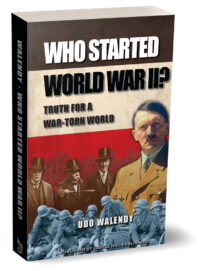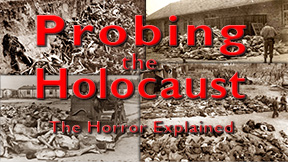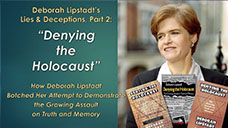The following foreword is part of Udo Walendy’s book Who Started World War II? Truth for a War-Torn World, which was published in 2014 and is being distributed by Castle Hill Publishers, UK (there on the pages 9-11). In the US, an unedited version without this foreword titled Truth for Germany: The Guilt Question of the Second World War can be had from The Barnes Review. The book is a completely new translation of Walendy’s 1964 German classic Wahrheit für Deutschland.
How can anyone in his right mind ask who caused the Second World War? Everybody knows who did it:
Hitler did it.
The Nazis did it.
The Germans did it.
End of story. So why ask?
But since you’ve started reading this book, chances are that you know already that truth is rarely that simple, or are at least willing to hear arguments to that effect.
After the end of the First World War, the victorious powers insisted that Germany take the full blame for the outbreak of that conflict. It is true that it was Germany who declared war on France and Russia, and not the other way around. But it is also true, as most historians acknowledge today, that Germany was the only great power of those days who seriously tried to avert this war, and who tried to stop it with numerous genuine, reasonable peace offers once it had been unleashed. These propositions simply fell on deaf ears and further, were concealed or even denied by their recipients. Hence, it is not always the nation firing the first shots who is primarily responsible for the ultimate course of an armed conflict.
In late 1918, after the U.S. had proposed a reasonable basis for peace negotiations – US President Wilson’s 14 Points – and after all powers involved had agreed upon it, Germany surrendered. But after the Germans had laid down their weapons, the other powers did not follow suit, as the armistice had provided. Quite to the contrary: The cease-fire agreement was repudiated and replaced with the plunder and rape of Germany in what is called the “Treaty of Versailles.”
Ever since Germany had been forced at gunpoint to sign this “treaty,” voices of reason could be heard all over the world stating that the conditions of this treaty must be revised, or else yet another major European conflagration would be inevitable. The greedy, hate-filled victorious powers, however, did not allow such a revision. Hence, when peaceful revisions failed, new tensions and finally a new war arose.
The Second World Wear is therefore nothing else but the continuation of the First World War. It is impossible to understand the second war without knowing the causes of the first war and how that war was ended. Both wars have to be seen as one unit, as a Thirty Years’ War.
It was not the first Thirty Years’ War on European soil – it was the second. The first happened between 1618 and 1648, when most of the great powers of Europe of that time – first and foremost the Church – struggled for control over the heart of Europe, that is: Germany. The consequences for Germany were devastating. It lost roughly one third of its population, mostly due to war-induced famines and epidemics, and became politically emasculated, unable to decide its own fate for two hundred years.
Even though the peace treaty which ended this first German catastrophe emplaced a national German paralysis for centuries, at least it didn’t blame anyone for the war and instead ordered a general amnesty for all the atrocities committed by all sides during the conflict, allowing everyone a fresh start. As we all know, that was not the case after the second Thirty Years’ War. First of all, there was no peace treaty with Germany, and there still isn’t. In addition, Germany has been made to carry the imposed burden of exclusive guilt, and while all the victors’ atrocities have been amnestied, denied and even forgotten, the vanquished nations are haunted to this very day by collective accusations, and their now-geriatric citizens who were involved in that war are still today in constant danger of being hunted down, dragged into show trials and thrown into prisons for crimes allegedly committed some 70+ years ago.
This second Thirty Years’ War had at its core a similar motivation. After Germany had overcome the political castration of the first Thirty Years’ War by uniting all northern and central German principalities under Prussian rule in 1871, it rapidly gained economic strength and was swiftly outcompeting all other great European powers. These powers in turn felt that they either had to control, weaken or even destroy this new, much smaller Germany in order to stop this apparently interminable German success story. The most radical proponent of that attitude was Great Britain. The UK saw its world dominance increasingly threatened by Germany, whose economic prowess had surpassed Britain’s just prior to the First World War. Although Germany had repeatedly offered Britain her assistance in maintaining the Empire, Britain was not willing to share her rule of the waves with her cousin Germany.
The Treaty of Versailles was designed to cripple Germany to the point where she would not be a serious competitor anymore. But Hitler derailed that plan. He reunited Germany, liberated her from the shackles of Versailles, and enabled Germany to economically rise from the ashes of Versailles with breath-taking speed. While the rest of the world continued to suffer from the Great Depression, Germany flourished and again outcompeted everyone within only a few years of Hitler’s rule.
Hitler had to be stopped.
Germany had to be stopped.
The job left undone after the First World War had to be finished.
And so it was done, again primarily orchestrated by Great Britain, as the reader of this book will discover.
Looking back today, 100 years after the outbreak of this second Thirty Years’ War, what were the consequences of this conflagration for Great Britain?
Let’s face it: When trying to destroy Germany in two world wars, Britain bit off far more than she could chew. Sure, Germany’s population was reduced by many millions by means of genocidal carpet bombings during the war and ethnic cleansings afterwards. Her territory shrank by one third. But Germany is still there, and she is thriving. On the other hand, the British Empire is gone, and the waves are now ruled by the US. Britain’s economy has been outcompeted, nay, trounced once again by Germany, and vast parts of the surviving British industry today are in no small part controlled by German corporations. Europe is being ruled from its financial centre: Frankfurt, Germany.
Britain, of course, is relegated to keep celebrating her victory over her Germanic cousins… a victory today so much less than empty.
And one last thing I would like the reader to consider: The Germans live on both blessed and cursed soil. During peace, most European commercial and cultural trade runs through Germany, as it lies in the very centre of that continent. Hence, during peace, Germany thrives. It thrives to the point where its neighbours get envious. Unlike many other nations, however, Germany has hardly any natural borders offering protection, and it is the country in Europe with the most contiguous neighbours – currently nine, and if we include Austria within Germany, even twelve. Hence, there is no spot in Europe where having envious neighbours is more perilous. And that is the reason for the German fate: pure geography. Any people living in such a location would face the very same exposure to political machinations by its neighbours. The reason for modern history’s devastating wars in central Europe is therefore not because the Germans are a belligerent, evil tribe. The Germans are no different than anyone else. It is simply a matter of political geography, or Geopolitik, as the Germans say.
Germar Rudolf, 18 August 2014







